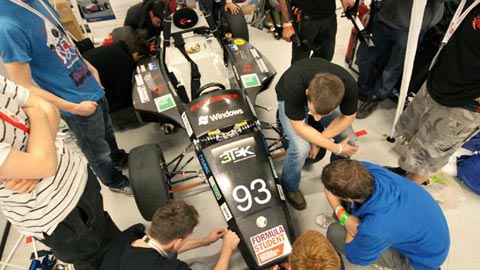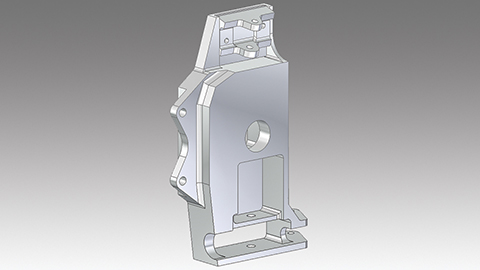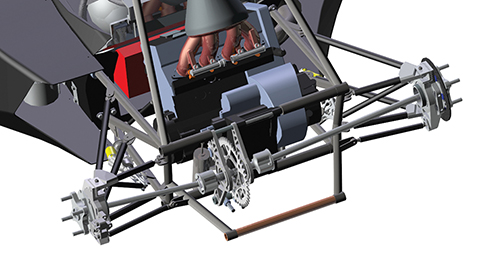SURTES Team
SURTES Team

SURTES team designs and delivers finely tuned car for Formula Student competition
Competition hones winning engineering skills
Home to the Formula 1 British Grand Prix, Silverstone is internationally renowned as the center of world-class motor racing. Since 2008, the circuit has played host to the Formula Student summer gathering of design teams from around the globe. Formula Student, also known as Formula SAE in some countries, is one of the leading educational motorsport programs. To participate, teams of student engineers have to produce a prototype car for evaluation in a range of static and dynamic events designed to demonstrate their understanding of engineering, as well as test the performance of their vehicles in a competition on the race track. An event in the U.K. effectively marks the start of a fresh racing season, where new cars are launched. The last event of the series takes place in the U.S.
One thing that excites an engineer is the thought of his or her design being proven in a competition, and few arenas present a better test for this than motorsports. The big question for an engineering student is: How will my race car perform on a Grand Prix race track? A number of University of Surrey students pursue that answer each year, going through the entire product design, engineering and manufacturing process. The competition helps students develop their technical knowledge and problem-solving abilities, as well as management, marketing, budgeting and interpersonal skills.

Collaboration moves team from concept to design
For the 2012 event, the team from Surrey University Racing Technology and Engineering Solutions (SURTES) launched its latest design, Stag 12. The team leader was aerospace engineering student Anthony Hinkley, who took responsibility for compiling the SURTES entry and submitting documents to the judges. “The project was certainly challenging in terms of the basic brief itself, plus we had a restricted budget and a fluctuating number of team members throughout the year,” says Hinkley.
At the start of the new academic year in October, the design team included nearly 30 undergraduate and postgraduate students of aerospace, electronic and mechanical engineering who chose to work on this project as part of their degree. At this stage the emphasis was on coordinating the effort of a large group. Inevitably, the size and makeup of the initial team changed in line with the team member’s academic priorities, and as the year progressed the management challenge shifted to ensuring the stability of a core group that took on more For the 2012 event, the team from Surrey University Racing Technology and Engineering Solutions (SURTES) launched its latest design, Stag 12. The team leader was aerospace engineering student Anthony Hinkley, who took responsibility for compiling the SURTES entry and submitting documents to the judges. “The project was certainly challenging in terms of the basic brief itself, plus we had a restricted budget and a fluctuating number of team members throughout the year,” says Hinkley. At the start of the new academic year in October, the design team included nearly 30 undergraduate and postgraduate students of aerospace, electronic and mechanical engineering who chose to work on this project as part of their degree. At this stage, the emphasis was on coordinating the effort of a large group. Inevitably, the size and makeup of the initial team changed in line with the team member’s academic priorities, and as the year progressed the management challenge shifted to ensuring the stability of a core group that took on more responsibility as the competition deadline was growing closer.
According to Hinkley, one major advantage was the ability to collaborate through the use of a shared tool: Solid Edge® software from Siemens PLM Software. “Surrey University uses Solid Edge within the engineering school and as full-time students, we were also able to obtain a free copy of Solid Edge Student for use at home. Everyone found Solid Edge to be very easy to learn, which was particularly important in the early stages of the project. It was easy to find familiar commands and to discover useful new commands. Because we were able to create solids (3D models) in the desired shapes, this software helped us to transfer an idea to reality. As we worked out our overall objectives, we were able to move from concept to basic design very quickly using Solid Edge. Team members then took on different areas of the car; for example, one or two team members worked on the chassis and most others worked on parts.”
Design decision-making put to the test
The Formula Student judges do consider aesthetic appearance, although it is secondary to functional requirements. The cars are put through their paces in four dynamic events, each testing one management, marketing, budgeting and interpersonal skills. Collaboration moves team from concept to design. For the 2012 event, the team from Surrey University Racing Technology and Engineering Solutions (SURTES) launched its latest design, Stag 12. The team leader was aerospace engineering student Anthony Hinkley, who took responsibility for compiling the SURTES entry and submitting documents to the judges. “The project was certainly challenging in terms of the basic brief itself, plus we had a restricted budget and a fluctuating number of team members throughout the year,” says Hinkley.
At the start of the new academic year in October, the design team included nearly 30 undergraduate and postgraduate students of aerospace, electronic and mechanical engineering who chose to work on this project as part of their degree. At this stage the emphasis was on coordinating the effort of a large group. Inevitably, the size and makeup of the initial team changed in line with the team member’s academic priorities, and as the year progressed the management challenge shifted to ensuring the stability of a core group that took on more aspect of the design. Acceleration is demonstrated with a short drag race from a standing start. Lateral control of the vehicle is tested by the driver, who is required to follow a figure-eight shape on a skid pan. Vehicle agility and driving ease are exposed by a point-to-point obstacle course over 1 kilometer (km). Finally, endurance is pushed to the limit by a 26-km time trial, with speed and fuel consumption being taken into account.
Once the season gets underway, minor design adjustments can be made but major modifications are banned, so early decision-making has to be sound. Hinkley explains how the team settled on design priorities for 2012: “In the past, SURTES cars had some reliability issues, because students were tempted to pursue a high-tech solution. The emphasis recently has been on good basic design, with particular focus on the drive-train.” The team opted for the predictability and affordability of a conventional drive shaft in 2012, after a carbon-fiber shaft had been used on the 2011 car.
Hinkley notes that the latest model resembles earlier versions, but beneath the visual similarities there are significant changes. Because Formula Student rules are quite flexible compared to Formula 1, the cars tend to be rather different in design. “Some, for example, use petrol; others run on alternative power such as batteries or hydrogen. Our car uses petrol – we decided to stay with this as it was cheaper and safer, and because we were more familiar with that technology than we were with battery power.”

A team’s justification of design choices is an important part of the overall assessment. “We needed to be clear exactly why we were making certain decisions,” says Hinkley. “For example, we decided that aerodynamics was not a main priority, because the cost-to-benefit ratio did not stack up in our favor given our restricted resources; and from preliminary computational fluid dynamics (CFD) analysis, the performance gains appeared to be minimal when considering average competition running speeds of 30 to 40 miles per hour (mph).”
Simple solution solves complex problems
In the three months of the first semester the team designed four major subsystems encompassing the chassis, powertrain, suspension and systems, completing a total of 1,500 small components using Solid Edge. The work was completed by the end of January 2012. That left less than five months for manufacture. Hinkley reports that the biggest technical challenge was the complexity of the design: “Because we were aiming to save weight, some of the shapes became rather complex and exotic. The geometry for some angles, for example the wheel brackets, was quite difficult to achieve.
“Manufacturability was a critical factor and we had to have detailed discussions with suppliers to make sure that what we had designed could be manufactured on time and on budget as we worked on optimization. In particular, some of the hubs and uprights were extremely complicated and we had to make modifications to the wheel housing and connections to the drive train.
”Members of the core team cite the assembly capabilities of Solid Edge as the most beneficial of the toolset. Hinkley explains,
“Solid Edge was most useful to ensure the relationship between parts was correct, avoiding collisions and ensuring parts fit correctly. For us, being able to edit parts within the assembly was the most-used and most important tool within Solid Edge. This function really helped us to virtually predict the car’s dynamic behavior in real life. In addition, the 2D drafting capability of Solid Edge was easy to use and provided an efficient way to generate drawings for suppliers.” All components were made in 3D and converted to detailed 2D engineering drawings.
Car runs perfectly
The final manufactured parts were received in late June, leaving the team with just one week to assemble everything before they transported the car to a test site near Silverstone. “We managed to get the car up and running the day before the competition and it ran perfectly, without any failures or technical issues. The core team of five drivers then headed to Silverstone to get the car through ‘scrutineering,’ the rigorous examination of car performance by the judges. That was the most worrying event for us, but in fact, there were no problems.”
“Despite our restricted resources and limited development time, we were very pleased that our car proved to be so reliable out-of-the-box,” says Hinkley. “We finished halfway up the league table of over 100 entrants against some very experienced and well-established teams. Formula Student is a serious business and some teams have significant budgets, so they can afford to invest in higher-performance parts. There are universities with incredible facilities at their disposal, such as extensive machine shops, wind tunnels and autoclaves. Others have close contact with industry sponsors and, therefore, have access to particular expertise. Fortunately, the judges take the situation of each team into account, so a limited budget is not necessarily a disadvantage. The judges seemed rather pleased with the overall design of the car and we are confident that we will improve our performance year by year.”
Business Challenges
- Design a race car on a limited budget
- Collaborate quickly and efficiently with a large team
- Get it right early
Keys to Success
- Access to a complete CAD system
- Ease of use and data sharing
- Assembly editing
- Design and manufacturing decision-making support
Results
- Complex parts optimized for manufacture
- Reliable component design
- Assembly in one day
- Scrutineering test passed without issue
- High performance on the race track
“Despite our restricted resources and limited development time we were very pleased that our car proved to be so reliable out-of-the-box.”
“Everyone found Solid Edge to be very easy to learn, which was particularly important in the early stages of the project.”
“For us, being able to edit parts within the assembly was the most-used and most-important tool within Solid Edge.”
Anthony Hinkley,
Team Leader
SURTES
